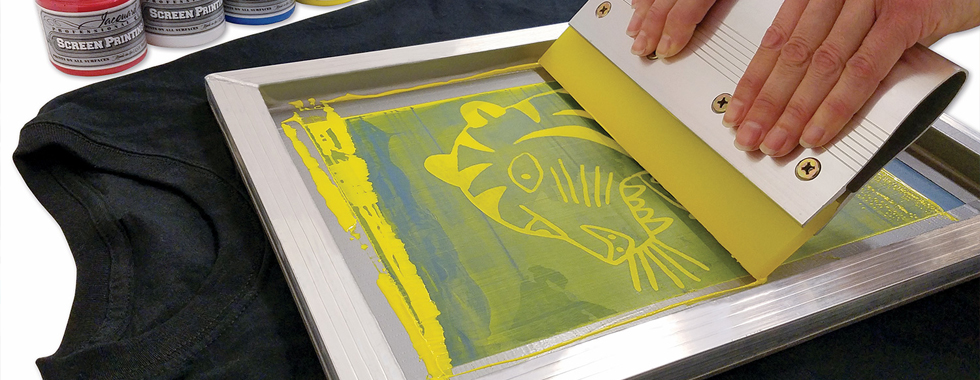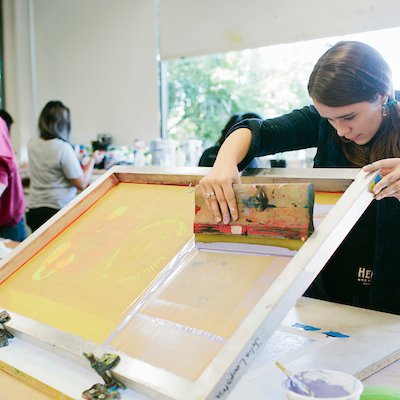The Necessary Overview to Recognizing Screen Printing and Its Versatile Uses
Screen printing has an abundant history that dates back to ancient times, evolving into an innovative technique used across numerous markets today. This guide explores the ins and outs of the screen printing procedure, detailing its applications in fashion, advertising, and home design - 10:9 Design Texas. Recognizing these basics can open up imaginative possibility for both artistic and business projects. The following areas will disclose crucial tips and techniques to enhance one's screen printing endeavors
The History of Screen Printing
Screen printing has roots that trace back centuries, its advancement shows the technical and artistic advancements of numerous societies. Originating in ancient China, the method was at first utilized for enhancing fabrics and later infect Japan, where it came to be essential to Ukiyo-e woodblock printing. The approach moved to Europe in the 18th century, where it obtained popularity among artisans and industrial printers. The invention of image solution in the 20th century revolutionized screen printing, permitting more complex styles and higher efficiency. Artists like Andy Warhol better thrust its popularity, making use of the medium to develop legendary jobs that blended commercialism and art. By the late 20th century, screen printing had actually established itself as a functional technique, used in style, advertising and marketing, and art. Today, it proceeds to evolve, integrating electronic technology and broadening its applications throughout various sectors.
The Screen Printing Process Explained
Screen printing transforms creative visions into substantial layouts with a series of specific steps. A photo is produced and then transferred onto a screen, generally made of great mesh textile stretched over a framework. A light-sensitive emulsion is applied to the screen, which is revealed to light, solidifying in locations not covered by the image. After rinsing the unhardened emulsion, a stencil is formed.
Next off, the screen is put over the substratum, whether it be fabric, paper, or one more product. Ink is after that pushed through the open areas of the pattern making use of a squeegee, transferring the design onto the substratum below. This process can be repeated for numerous shades, calling for separate displays for each shade. The printed product is treated utilizing warmth to guarantee the ink adheres correctly, resulting in a resilient, dynamic layout ready for usage.
Kinds of Screen Printing Techniques

Furthermore, specialty techniques, such as discharge screen printing, eliminate dye from the textile to develop softer prints, while foil screen printing applies metallic aluminum foil to accomplish a glossy coating (10:9 Design Company). Each technique supplies unique qualities, dealing with numerous imaginative requirements and production scales, inevitably expanding the opportunities within the screen printing domain
Applications of Screen Printing in Different Industries

Additionally, the signs and advertising sectors utilize screen printing for creating attractive displays and banners. This technique permits for bold colors and elaborate designs that catch attention. In electronic devices, screen printing is used for using conductive inks to circuit card, important for component links. Additionally, the home décor market welcomes screen printing to generate distinct layouts on fabrics and wall art. Overall, screen printing acts as an essential device throughout varied areas, enhancing items with personalized and visually enticing graphics.
Tips for Effective Screen Printing Projects
While undertaking a screen printing project, careful attention to detail can significantly enhance the last result. Initially, picking high-quality materials is necessary; this consists of the screen, inks, and substratums. Using suitable mesh matters can influence ink deposition and information resolution. Preparation is just as vital; thorough cleaning of screens and proper direct exposure times ensure crisp prints.
Next off, accurate enrollment is important for multi-color prints. Making use of placement devices can aid accomplish accurate layering. In addition, testing prints on scrap materials prior to manufacturing assists determine possible problems without losing sources.

Regularly Asked Questions
What Products Are Ideal for Screen Printing on Textile?
Cotton and polyester blends are suitable for screen printing on material as a result of their resilience and ink absorption. In addition, specialty textiles like silk or canvas can create special textures and finishes, improving the total layout quality.
Just how Do I Clean and Maintain Screen Printing Devices?
To clean up and maintain screen printing tools, one must on a regular basis clean screens with suitable solvents, evaluate squeegees for wear, oil relocating parts, and shop all things in a completely dry, dust-free setting to read more extend their life expectancy.
What Are the Ecological Effects of Screen Printing?
Screen printing can have substantial ecological effects, including chemical waste from solvents and inks, water use throughout cleansing processes, and energy usage. Environment-friendly products and sustainable techniques are necessary for lessening these adverse effects.
Can Screen Printing Be Done in your home Efficiently?
Screen printing can be properly done at home with the ideal materials and strategies. Enthusiasts can produce high quality prints, though success depends on their skill degree, tools, and understanding of the procedure entailed.
What Are the Expenses Connected With Starting a Screen Printing Service?

Beginning a screen printing organization involves expenses for tools, products, and work space. Initial costs usually range from a few hundred to numerous thousand bucks, depending on the range, high quality of machinery, and wanted production capability.
Screen printing has an abundant background that dates back to ancient times, progressing right into an advanced method used throughout numerous sectors today. Another method, rotary screen printing, utilizes cylindrical screens, facilitating continuous printing on material rolls, thus boosting performance for large productions. Additionally, specialized methods, such as discharge screen printing, remove color from the textile to create softer prints, while aluminum foil screen printing uses metal foil to attain a shiny finish. In the style market, screen printing is extensively utilized to create vivid designs on clothing, enabling brands to showcase their unique styles. Cotton and polyester blends are optimal for screen printing on textile due to their durability and ink absorption.